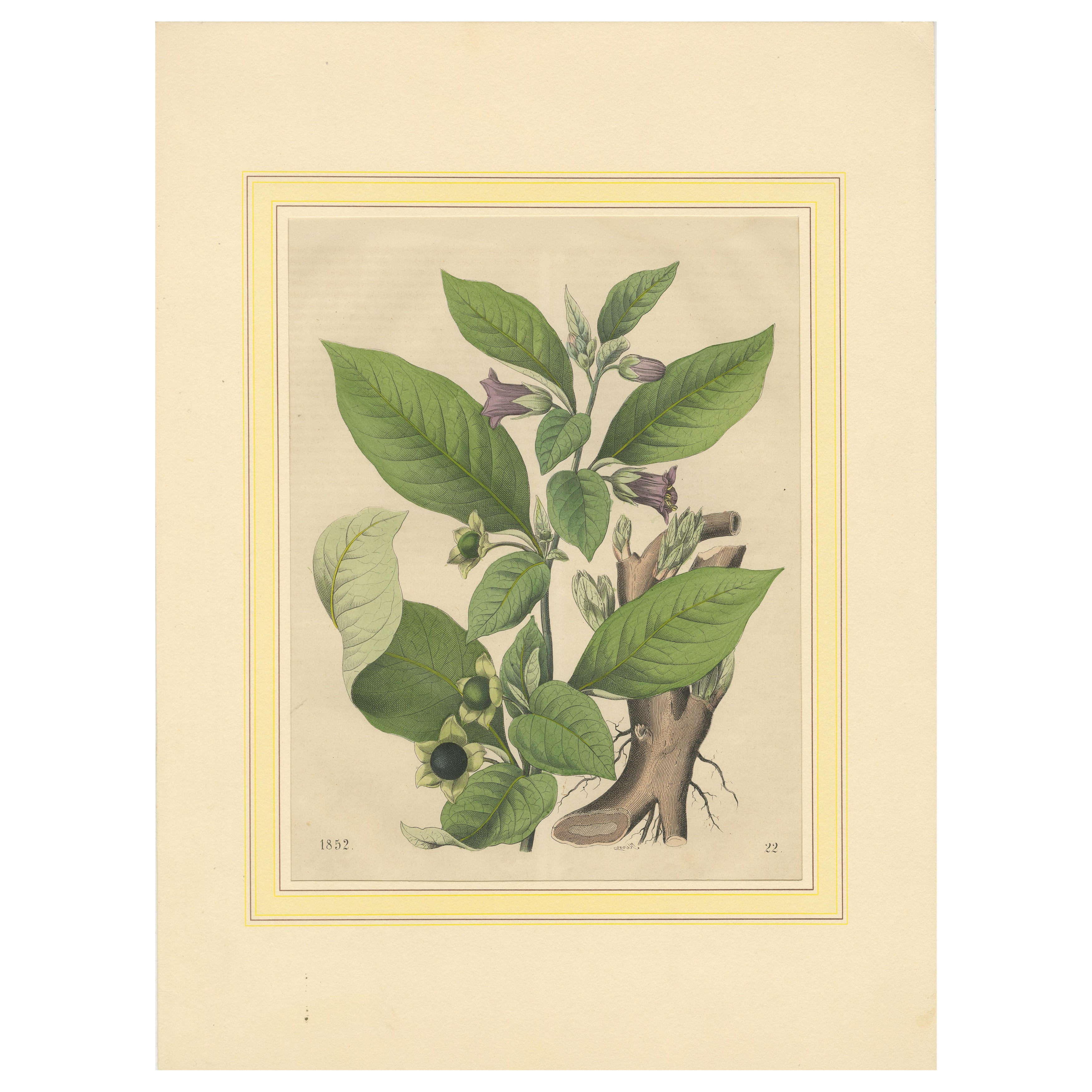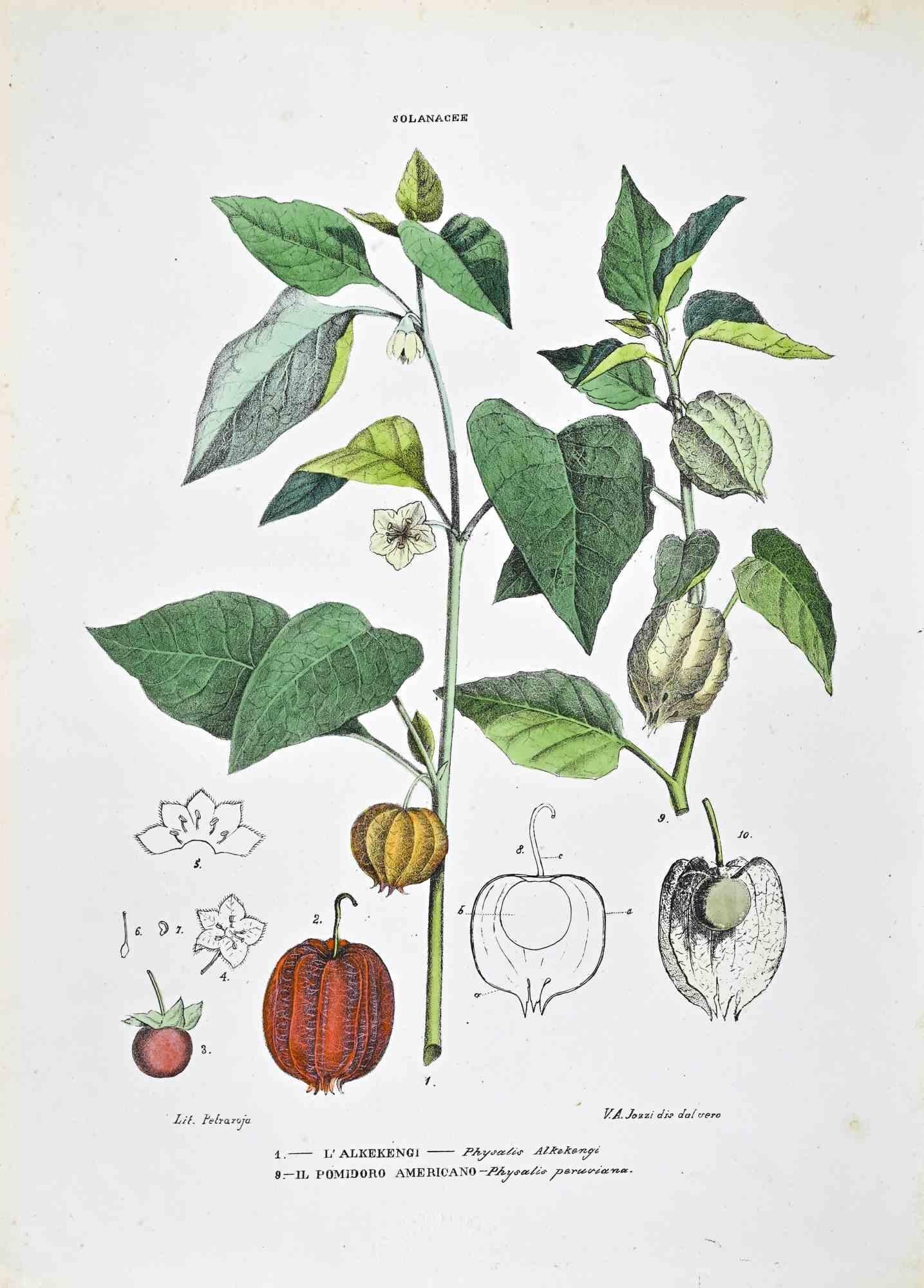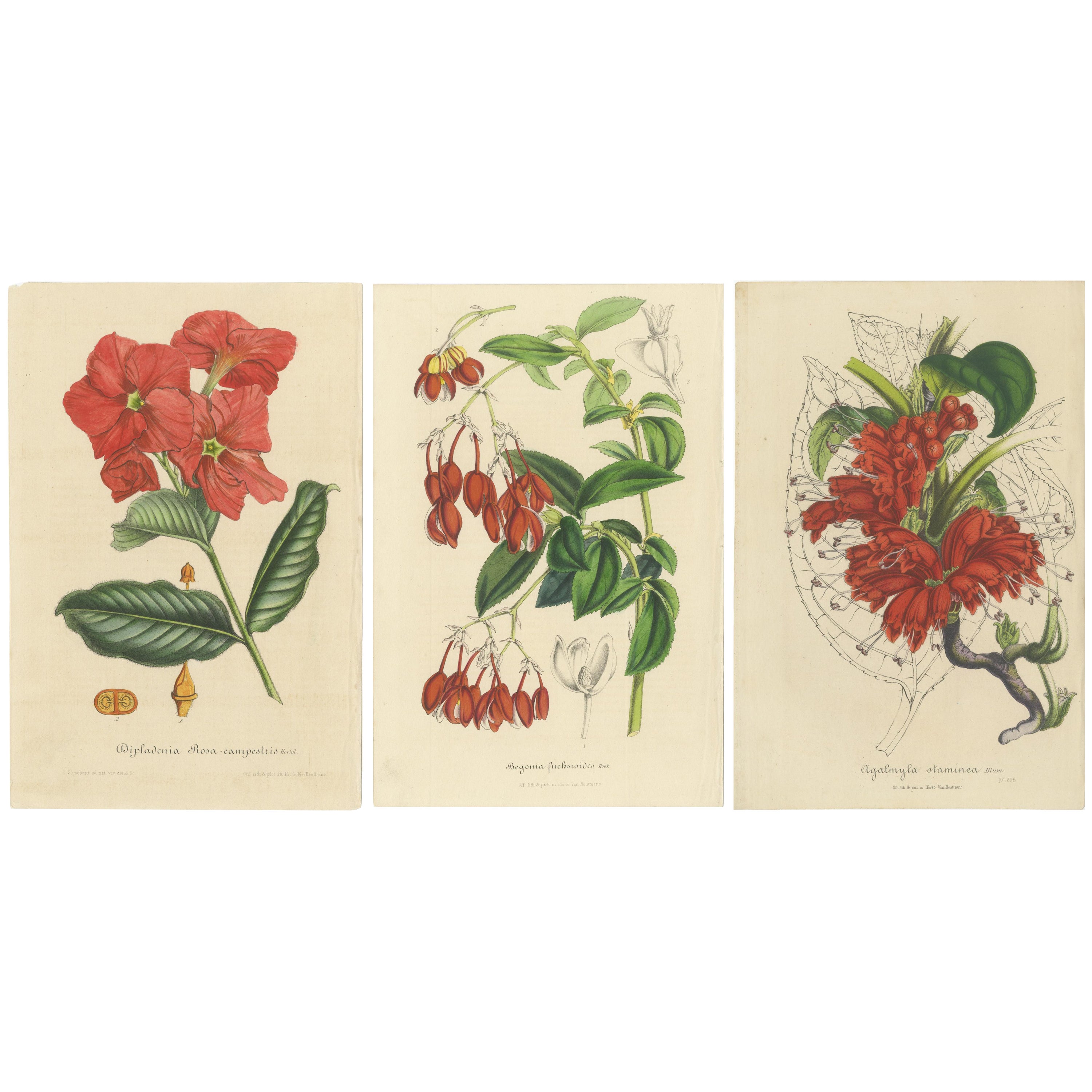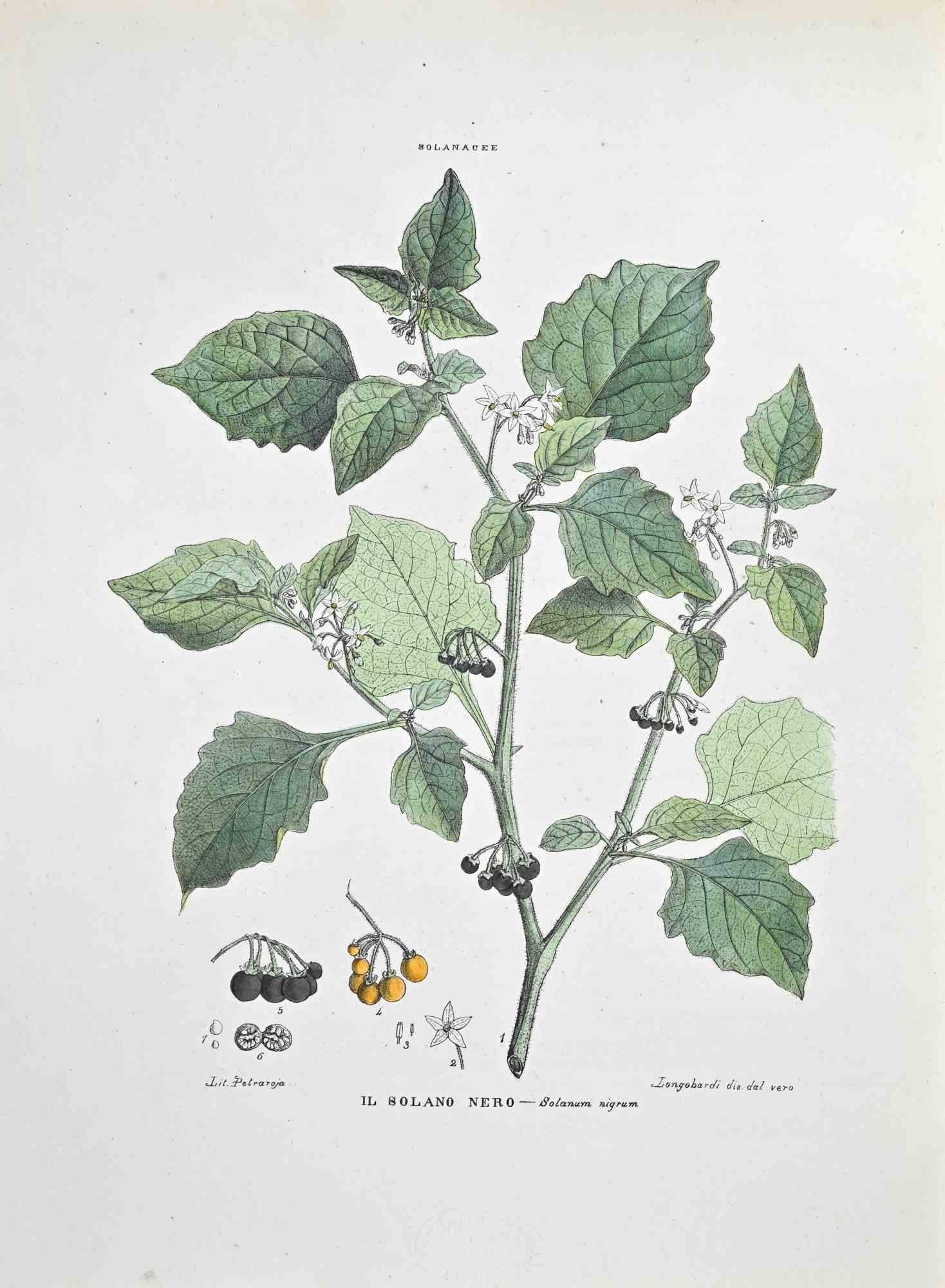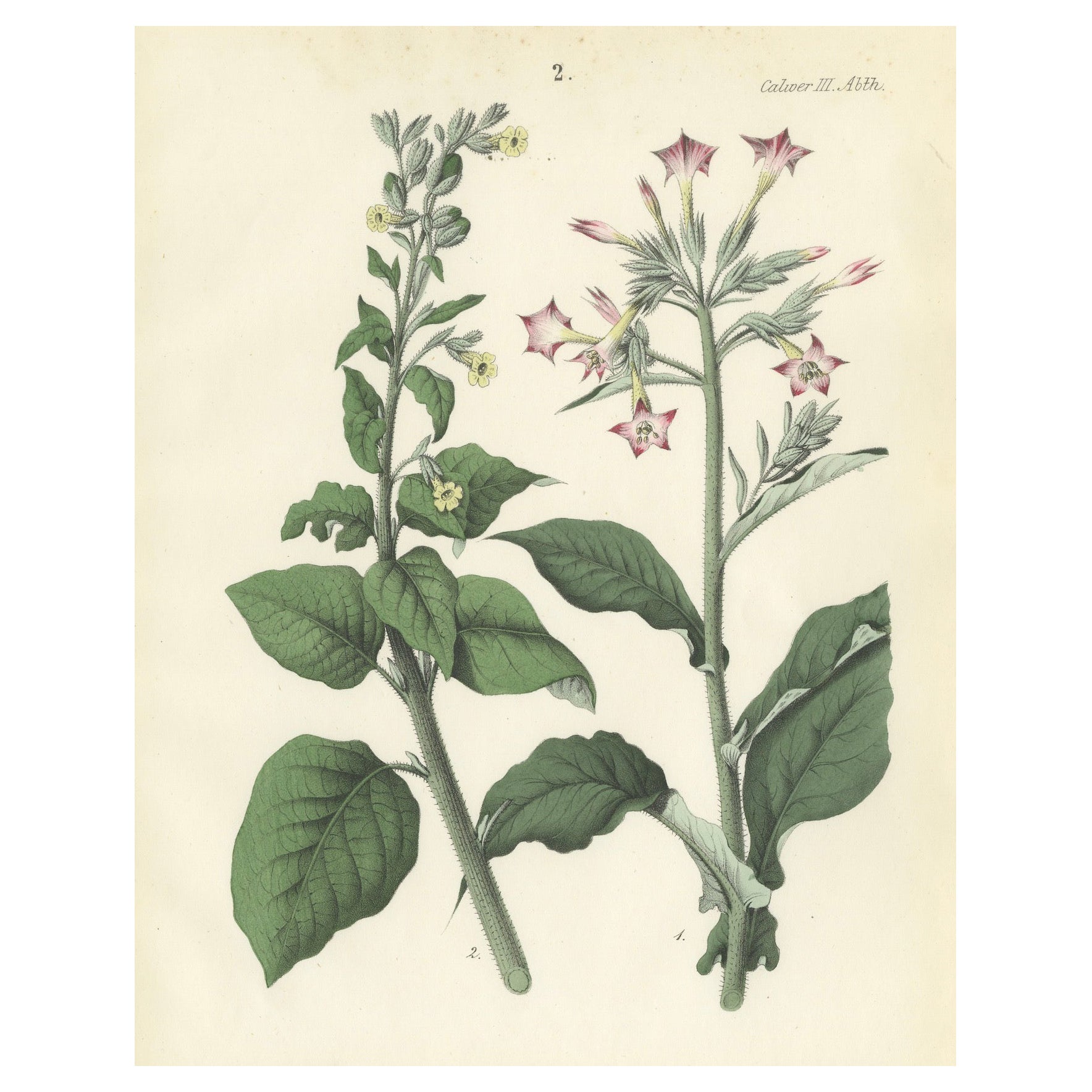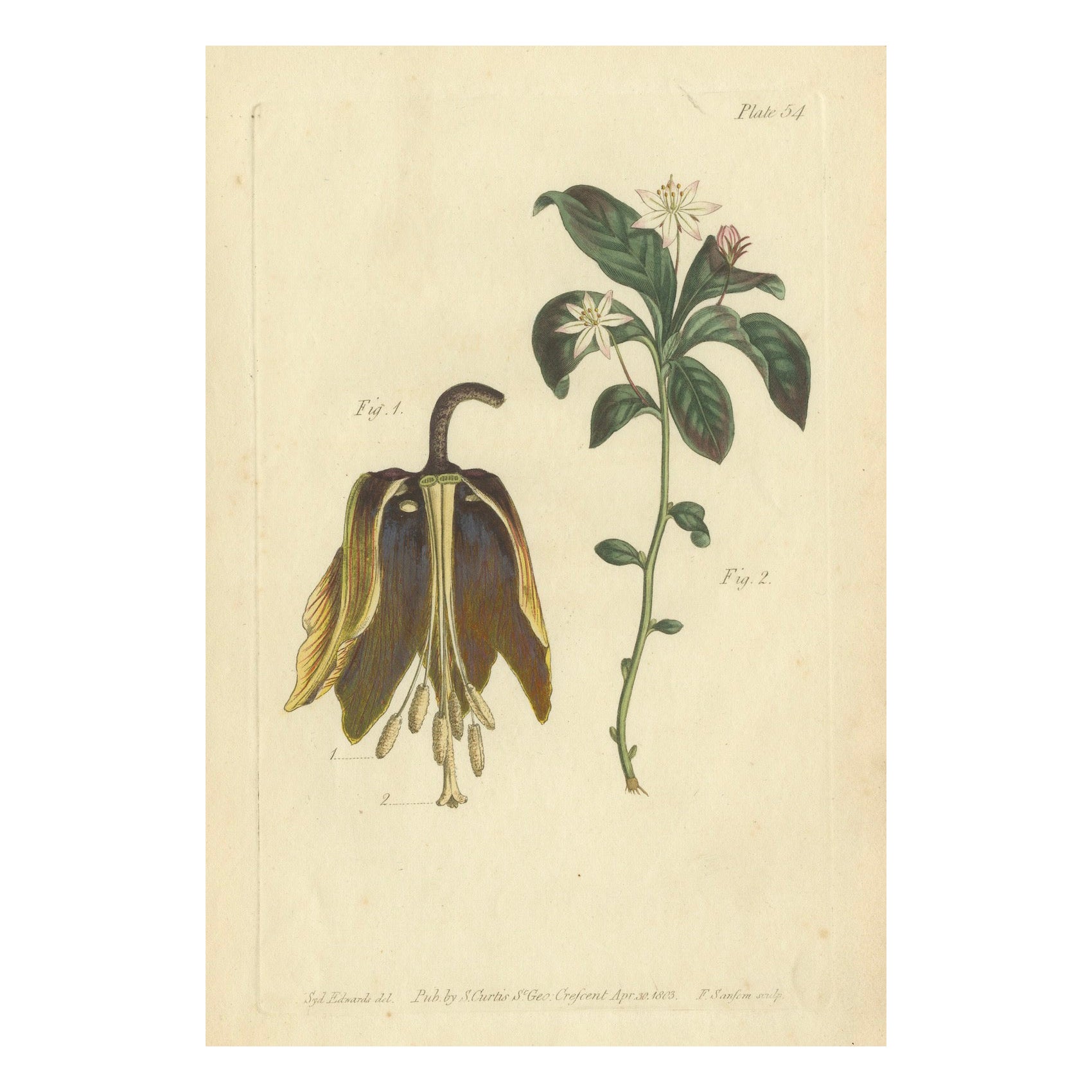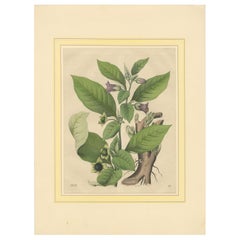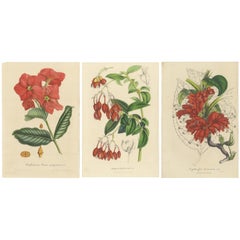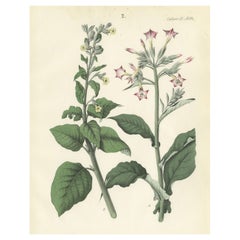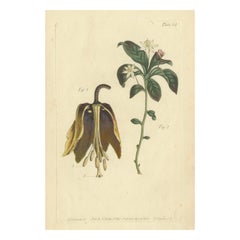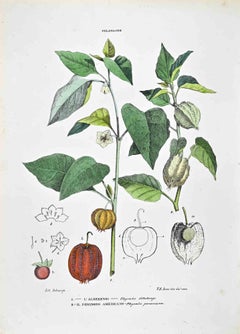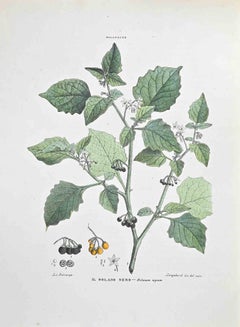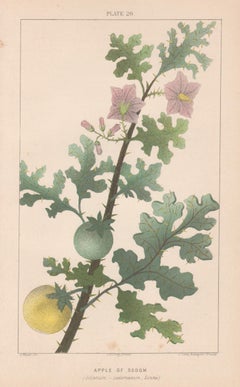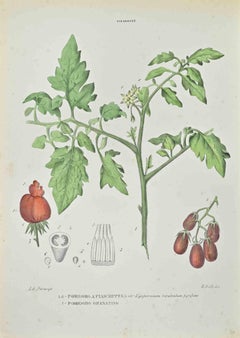Items Similar to Texas Nightshade Botanical Illustration by Louis van Houtte, 19th Century
Want more images or videos?
Request additional images or videos from the seller
1 of 6
Texas Nightshade Botanical Illustration by Louis van Houtte, 19th Century
$134.19
$167.7420% Off
£99.90
£124.8720% Off
€112
€14020% Off
CA$183.81
CA$229.7620% Off
A$204.44
A$255.5520% Off
CHF 106.75
CHF 133.4420% Off
MX$2,487.77
MX$3,109.7220% Off
NOK 1,363.36
NOK 1,704.2120% Off
SEK 1,278.60
SEK 1,598.2420% Off
DKK 852.62
DKK 1,065.7720% Off
Shipping
Retrieving quote...The 1stDibs Promise:
Authenticity Guarantee,
Money-Back Guarantee,
24-Hour Cancellation
About the Item
Texas Nightshade Botanical Illustration by Louis van Houtte, 19th Century
This botanical illustration features *Solanum texanum*, commonly known as Texas Nightshade, a plant recognized for its vibrant fruits and distinct leaves.
The artwork, measuring approximately 24 x 16 cm (9.5 x 6.5 inches), is part of the acclaimed "Flore des Serres et des Jardins de l'Europe," a collection by Louis van Houtte, a prominent 19th-century Belgian horticulturist.
Van Houtte's work is celebrated for its detailed and colorful depictions of a wide range of plant species, both exotic and native.
The *Solanum texanum* illustrated here is native to Texas, as indicated by the label "Texas." The plant is depicted with its characteristic large, rounded leaves and clusters of vibrant, pumpkin-shaped fruits that transition from green to a bright red as they mature. The flowers, shown at the top of the plant, are small and star-shaped, typical of the nightshade family.
The term "plein air" suggests that this plant is suited to growing in open air conditions, thriving in the natural environment of its native region.
The lithograph was created using lithography, a printing technique that involves using a stone or metal plate, with hand coloring to enhance the vibrant hues and intricate details of the plant.
The print is well-preserved, with the colors and fine details clearly visible, reflecting the high quality of Louis van Houtte's botanical illustrations and the care taken in their preservation.
- Dimensions:Height: 9.45 in (24 cm)Width: 6.3 in (16 cm)Depth: 0.01 in (0.2 mm)
- Materials and Techniques:
- Period:
- Date of Manufacture:Circa 1855
- Condition:The condition of this print is good, with vibrant colors and clear details that have been well-preserved over time. General age-related toning and/or occasional minor defects from handling. Please study scans carefully.
- Seller Location:Langweer, NL
- Reference Number:Seller: BG-13748-121stDibs: LU3054341290812
About the Seller
5.0
Recognized Seller
These prestigious sellers are industry leaders and represent the highest echelon for item quality and design.
Platinum Seller
Premium sellers with a 4.7+ rating and 24-hour response times
Established in 2009
1stDibs seller since 2017
2,510 sales on 1stDibs
Typical response time: <1 hour
- ShippingRetrieving quote...Shipping from: Langweer, Netherlands
- Return Policy
Authenticity Guarantee
In the unlikely event there’s an issue with an item’s authenticity, contact us within 1 year for a full refund. DetailsMoney-Back Guarantee
If your item is not as described, is damaged in transit, or does not arrive, contact us within 7 days for a full refund. Details24-Hour Cancellation
You have a 24-hour grace period in which to reconsider your purchase, with no questions asked.Vetted Professional Sellers
Our world-class sellers must adhere to strict standards for service and quality, maintaining the integrity of our listings.Price-Match Guarantee
If you find that a seller listed the same item for a lower price elsewhere, we’ll match it.Trusted Global Delivery
Our best-in-class carrier network provides specialized shipping options worldwide, including custom delivery.More From This Seller
View All1852 Botanical Lithograph of Atropa Belladonna (Deadly Nightshade)
Located in Langweer, NL
title: 1852 Botanical Lithograph of Atropa Belladonna (Deadly Nightshade)
Description: This finely detailed 1852 botanical lithograph showcases 'Atropa belladonna', commonly known...
Category
Antique 1850s Prints
Materials
Paper
Exquisite Botanical Illustrations from Curtis’s Botanical Magazine (1847)
Located in Langweer, NL
These beautiful hand-colored botanical illustrations, drawn and lithographed by the renowned artist Walter Hood Fitch, were featured in Sir William Jackson Hooker's *"Curtis's Botanical Magazine,"* published in London in 1847. Fitch was one of the most prolific and skilled botanical illustrators of the 19th century, known for his ability to capture the intricate details and vibrant hues of the plants he depicted.
Sir William Jackson Hooker, a famous British botanist and the director of the Royal Botanic Gardens, Kew, commissioned these illustrations as part of his work to document newly discovered plants from around the world. The *Curtis’s Botanical Magazine* has been published since 1787 and remains one of the longest-running botanical periodicals.
Detailed Descriptions of Each Plant
#### 1. **Dipladenia Rosa-campestris** (*Hortul. ex Veitch*)
- **English Name**: Rose Dipladenia
- **Description**: This illustration showcases *Dipladenia rosa-campestris*, a striking flowering plant known for its showy pink to deep red trumpet-shaped flowers. Native to tropical regions of South America, particularly Brazil, *Dipladenia* belongs to the family Apocynaceae and is prized in horticulture for its vibrant blooms and ability to climb. Fitch's illustration emphasizes the waxy leaves and the vivid color of the petals, bringing the plant to life on the page.
#### 2. **Begonia fuchsioides** (*Hook.*)
- **English Name**: Fuchsia-flowered Begonia
- **Description**: The *Begonia fuchsioides* is depicted with its characteristic red, pendulous flowers, which closely resemble the blooms of fuchsia plants. This species of Begonia is native to tropical regions and is popular for its delicate, bell-shaped flowers and glossy leaves. Fitch’s attention to the arrangement of the leaves and the contrast between the flowers' vibrant red and the soft green leaves provides a lifelike representation of this exotic plant.
#### 3. **Agalmyla staminea** (*Blume*)
- **English Name**: Staminate Agalmyla
- **Description**: This illustration captures the unique red tubular flowers of *Agalmyla staminea*, a plant native to Southeast Asia. The species is part of the Gesneriaceae family and is known for its bright, showy flowers that grow in dense clusters. Fitch’s careful rendering of the plant’s leaves and the intricate veining, along with the vibrant red flowers, highlights his talent for bringing the botanical subject to life with both scientific accuracy and artistic flair.
### About the Makers
#### **Walter Hood Fitch** (Artist and Lithographer)
Walter Hood Fitch (1817–1892) was one of the most influential botanical artists of the 19th century, working primarily with Sir William Hooker and later his son, Joseph Dalton Hooker, at Kew Gardens. He produced thousands of illustrations for various botanical publications, including *Curtis’s Botanical Magazine*, where he was responsible for the majority of its plates from 1834 to 1877. Fitch’s mastery of lithography allowed him to create richly detailed and accurate depictions of plants, with a particular talent for illustrating both the botanical structure and the vibrant colors of flowers.
#### **Sir William Jackson Hooker** (Director and Editor)
Sir William Jackson Hooker (1785–1865) was a prominent British botanist and the director of the Royal Botanic Gardens, Kew. Under his leadership, Kew Gardens expanded its collection of plants from around the world, and Hooker was instrumental in promoting the scientific study and illustration of these species. As the editor of *Curtis’s Botanical Magazine*, Hooker collaborated with Fitch to document and share the beauty and diversity of plants with the scientific community and the public.
### The Lithographic Technique
Lithography, particularly chromolithography, was a crucial innovation in botanical illustration. Fitch was skilled in the traditional method of lithography, where an image was drawn onto a stone plate with a greasy substance and then inked for printing. Hand-coloring was often applied afterward to bring the prints to life, as seen in these illustrations. This method allowed for highly detailed, accurate representations of plants and their botanical features, making it invaluable for both scientific study and aesthetic appreciation.
### Conclusion
These prints from *Curtis’s Botanical Magazine* reflect the height of botanical art in the mid-19th century. The combination of Walter Fitch...
Category
Antique 1840s Prints
Materials
Paper
$412 Sale Price / set
20% Off
Hand-Colored Botanical Litho of Nicotiana Tabacum and Nicotiana Rustica, 1854
Located in Langweer, NL
Hand-Colored Botanical Lithograph of Nicotiana Tabacum and Nicotiana Rustica, 1854
This striking hand-colored botanical lithograph is from Carl Georg Calwer’s 'Deutschlands Tech...
Category
Antique 1850s Prints
Materials
Paper
Antique Botanical Print of Banana Shrub and Starry Wild Jasmine, 1803
Located in Langweer, NL
Title: Antique Botanical Print of Banana Shrub and Starry Wild Jasmine, 1803
This title accurately reflects the plant subjects depicted in the illustration: the Banana Shrub (Fig. 1, showing the seed pod) and the Starry Wild Jasmine (Fig. 2, showing the flower in bloom).
This antique engraving from April 23, 1803, beautifully illustrates two botanical figures, emphasizing the natural beauty and complexity of plant life. Here's what makes these illustrations unique and special:
1. Botanical Detail: Fig. 1 shows a plant section with a dark, almost wilted appearance, possibly representing the fruiting body or a seed pod, which contrasts with the lively and vibrant Fig. 2, depicting a flower in bloom. This juxtaposition captures both the end and the beginning of life cycles in the plant kingdom, showcasing the botanical accuracy and attention to detail that was essential in early scientific illustrations.
2. Artistic Technique: The illustration is a fine example of handcolored copperplate engraving, a method that requires exceptional skill. This technique allows for precise details and subtle gradations of color, qualities that make antique botanical prints highly valued by collectors and art enthusiasts alike.
3. Historical and Educational Value: Published by W. Curtis at St. George Crescent in 1803, this work is part of a larger series that aimed to educate and inform about the diversity of plant species. Such prints are crucial for understanding how plants were studied and classified in the early 19th century, providing insight into the history of botany and scientific illustration.
4. Collectibility: Due to their age, artistic merit, and the detailed craftsmanship, prints like these are sought after by collectors of antique botanical art...
Category
Antique Early 1800s Prints
Materials
Paper
$134 Sale Price
20% Off
Botanical Illustration of Little Kurrajong: Brachychiton Bidwillii, c.1855
Located in Langweer, NL
Botanical Illustration of Little Kurrajong: Brachychiton bidwillii
This lithograph features the Brachychiton bidwillii, commonly known as the Little Kurrajong. Native to Australia, this small tree or shrub is appreciated for its stunning red or pink bell-shaped flowers and large, lobed leaves. The illustration captures the plant's unique floral structure and the texture of its leaves, alongside detailed depictions of its reproductive parts, highlighting the botanical intricacies of the species.
This artwork is part of the renowned botanical series "Flore des Serres et des Jardins de l'Europe," created by Louis van Houtte, a prominent Belgian horticulturist in the 19th century. Van Houtte's works are celebrated for their scientific accuracy and artistic quality, making significant contributions to the understanding and appreciation of global plant diversity.
The lithograph employs hand-coloring, a technique that was commonly used during the period to achieve vivid, lifelike representations of plants.
The condition of this print is well-preserved, showing vibrant colors and fine details, with minor signs of aging such as slight foxing, which is typical of antique botanical illustrations...
Category
Antique 1850s Prints
Materials
Paper
$134 Sale Price
20% Off
Convolvulus Jalapa Botanical Engraving - Icones Plantarum Medicinalium, 1788
Located in Langweer, NL
"Convolvulus Jalapa Botanical Engraving - Icones Plantarum Medicinalium, 1788"
Description
This hand-colored engraving presents the Convolvulus Jalapa, commonly known as the Jalap b...
Category
Antique 1780s Prints
Materials
Paper
$277 Sale Price
20% Off
You May Also Like
The Solanaceae - Lithograph by Vincenzo Tenore - 1870s
Located in Roma, IT
Lithograph hand watercolored.
Plate from "Atlante di Botanica popolare ossia Illustrazione di Piante Notevoli di ogni famiglia" (Atlas of popular botany or illustration of notable p...
Category
1870s Modern Figurative Prints
Materials
Lithograph
The Black Solanum - Lithograph by Vincenzo Tenore - 1870s
Located in Roma, IT
Lithograph hand watercolored.
Plate from "Atlante di Botanica popolare ossia Illustrazione di Piante Notevoli di ogni famiglia" (Atlas of popular botany or illustration of notable p...
Category
1870s Modern Figurative Prints
Materials
Lithograph
Apple of Sodom (Solanum - sodomaeum, Linne), antique botanical plant lithograph
Located in Melbourne, Victoria
'Apple of Sodom (Solanum - sodomaeum, Linne)'
Colour lithograph, 1909.
Category
Early 20th Century Naturalistic More Prints
Materials
Lithograph
Tomatoes Plants - Lithograph by Vincenzo Tenore - 1870s
Located in Roma, IT
Lithograph hand watercolored.
Belongs to the Series "Atlante di Botanica popolare ossia Illustrazione di Piante Notevoli di ogni famiglia" (Atlas of popular botany or illustration o...
Category
1870s Modern Figurative Prints
Materials
Lithograph
The Thorny Solanum - Lithograph by Vincenzo Tenore - 1870s
Located in Roma, IT
Lithograph hand watercolored.
Plate from "Atlante di Botanica popolare ossia Illustrazione di Piante Notevoli di ogni famiglia" (Atlas of popular botany or illustration of notable p...
Category
1870s Modern Figurative Prints
Materials
Lithograph
The Anonaceae - Lithograph by Vincenzo Tenore - 1870s
Located in Roma, IT
Lithograph hand watercolored.
Plate from "Atlante di Botanica popolare ossia Illustrazione di Piante Notevoli di ogni famiglia" (Atlas of popular botany or illustration of notable p...
Category
1870s Modern Figurative Prints
Materials
Lithograph
